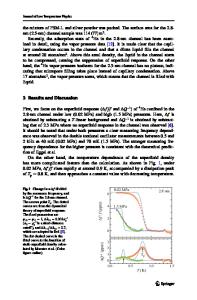Superfluid 3 He in a Nematic Aerogel
- PDF / 1,014,253 Bytes
- 9 Pages / 612 x 792 pts (letter) Page_size
- 14 Downloads / 353 Views
luid 3He in a Nematic Aerogel V. V. Dmitrieva,*, A. A. Soldatova, and A. N. Yudina aKapitza
Institute for Physical Problems, Russian Academy of Sciences, Moscow, 119334 Russia *e-mail: [email protected] Received March 24, 2020; revised March 24, 2020; accepted March 24, 2020
Abstract—In nematic aerogels, their constituent fibers are oriented along the same direction. In liquid 3He filling such aerogels, the scattering of Fermi quasiparticles at ultralow temperatures becomes anisotropic. This makes it possible to obtain new superfluid phases of 3He, which are not observed in bulk 3He. In this article, results of NMR investigation of these new superfluid phases of 3He in aerogels with different porosities are compared. We describe the methods for identifying these phases and consider some topological defects observed in them. DOI: 10.1134/S106377612007002X
1. INTRODUCTION
It is impossible to introduce impurities into liquid by conventional methods, but this can be done using a low-density aerogel immersed in liquid 3He. Aerogel is a high-porosity nanostructure consisting of strands that form a hard frame. In first experiments with 3He, SiO2 (silica) aerogels with a porosity of 97– 99% were used. The mean free path of Fermi quasiparticles in such aerogels exceeds the coherence length of superfluid 3He (20–80 nm depending on pressure), and the characteristic diameter of strands (about 3 nm) is smaller than this length. In this case, the strands can indeed be treated as impurities. Most of silica aerogels are nearly isotropic, and in weak magnetic fields two superfluid (A-like and B-like) are observed in these aerogels; the order parameters of these phases correspond to the order parameters of the A and B phases of bulk 3He. It turns out that weak anisotropy (produced, for example, by uniaxial deformation of the aerogel) affects the observed properties of the phases. Experiments show that this is due to a change in the spatial structure of phases, but not a change in the type of the order parameter. In particular, the order parameter of the A-like phase corresponds to the A phase, but depending on the magnitude and type of anisotropy (“stretching” or “squeezing”), it can be either in a spatially homogeneous state oriented by anisotropy, or in a disordered Larkin– Imry–Ma (LIM) state. For the observation of the polar phase, the stretching-type anisotropy must be strong, in which the effective mean free path for quasiparticles is maximal along a single preferred direction (direction of stretching). Yet, the large magnitude of anisotropy of this type in silica aerogels cannot be attained because of their brittleness. However, the polar, polar-distorted A phase, and polar-distorted B phases have been observed using so-called nematic 3He
Superfluidity of 3He is associated with Cooper pairing in which the orbital angular momentum and the spin of a pair is equal to 1. Such a triplet pairing leads to a variety of physical properties and allows the existence of a large number of superfluid phases with different wavefunc
Data Loading...











